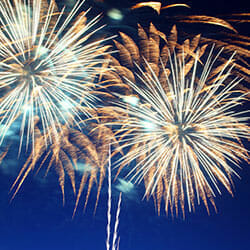
National Fireworks Safety Month Aims to Raise Awareness of Risks
- June 15
- Evans/Reilley
- Personal Injury
Fireworks are an Independence Day tradition, with many communities holding professional fireworks shows on or near July 4. And in yards around the United States, families set off their own fireworks, too. Every year, though, some of those home fireworks shows go awry, sending thousands of people to emergency rooms for burns and other injuries.
In the weeks surrounding Independence Day, an average of 230 people per day seek emergency room treatment for fireworks-related injuries. National Fireworks Safety Month, which is observed between June 1 and July 4, intends to educate the public about the dangers of fireworks and reduce the incidence of fireworks-related injuries.
About Fireworks Accidents
In its 2014 Fireworks Annual Report released in June 2015, the Consumer Product Safety Commission reported 11 fireworks-related deaths in 2014 – four deaths in house fires ignited by fireworks and seven deaths from direct impact of fireworks. And of the roughly 10,500 emergency room visits for fireworks-related injuries, about 7,000 of them occurred between June 20 and July 20.
Fireworks accidents are often the result of misuse, such as holding a device that’s meant to be set on the ground. Some people also dismantle or tamper with fireworks, because they’re trying to make their own customized device, and homemade fireworks are often unstable and dangerous. In 2014, one man lost both legs and one arm, and later died from his injuries, after his home exploded. Investigators concluded the man had been making illegal fireworks at the time, because he had been manufacturing homemade fireworks for at least two years.
The National Council on Fireworks Safety recommends that consumers buy fireworks only from licensed stands or stores – never from an individual selling fireworks on the street or from a home, because individuals are usually selling illegal explosives, or powerful explosives intended only for use by pyrotechnic professionals.
Fireworks may also injure people due to malfunction or because people are standing too close to the device. Even sparklers, which are often considered to be “kid-friendly,” caused 1,400 injuries in 2014, and 1,000 of those victims were age 14 or younger.
Types of Injuries
Burns are the most common type of fireworks-related injury, and hands are the body part most frequently injured in a fireworks accident. Those injuries may include minor burns to the hand, deep-tissue burns, hand fractures, and finger amputations – all injuries that could leave a person with a permanent disability.
Fireworks also cause eye injuries when they misfire, or when a person is standing too close to the device. Horseplay – such as throwing a lit firecracker at someone – can result in eye injuries, too.
Fireworks Safety
The CPSC report includes several accounts of injuries that occurred because a firework acted unpredictably. So, even if someone is cautious and stands what is presumed to be a safe distance from a firework, that distance may not be great enough if the firework explodes or sends a missile sideways instead of upwards.
The National Council on Fireworks Safety offers some tips for staying safe around fireworks this holiday season:
- Never give fireworks to children.
- Avoid alcohol.
- Wear safety glasses.
- Light one firework at a time and move away quickly.
- Always keep a bucket of water and water hose nearby.
- If a firework doesn’t “go off,” don’t approach it right away – wait at least 20 minutes, then soak it in a bucket of water to ensure it doesn’t ignite.
- Collect spent fireworks, soak them with water, and put them in a metal trashcan, away from combustible materials

 Serving Clients Throughout Texas
Serving Clients Throughout Texas
 Chip Evans is a partner at Evans & Herlihy. Chip brings to the firm more than 20 years of experience as a trial lawyer representing Plaintiffs. It is the desire to help individuals, not corporations, that attracts Chip to this side of the docket. [
Chip Evans is a partner at Evans & Herlihy. Chip brings to the firm more than 20 years of experience as a trial lawyer representing Plaintiffs. It is the desire to help individuals, not corporations, that attracts Chip to this side of the docket. [